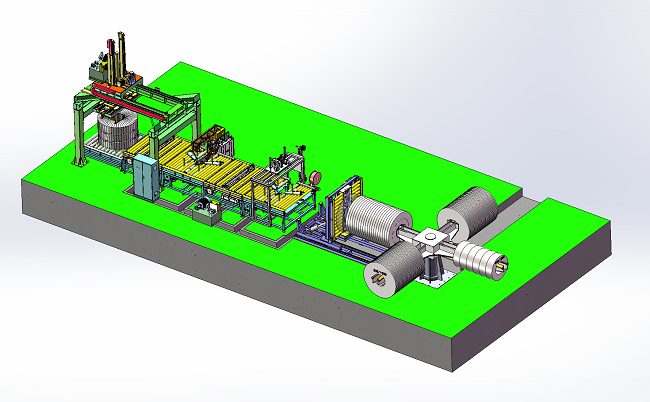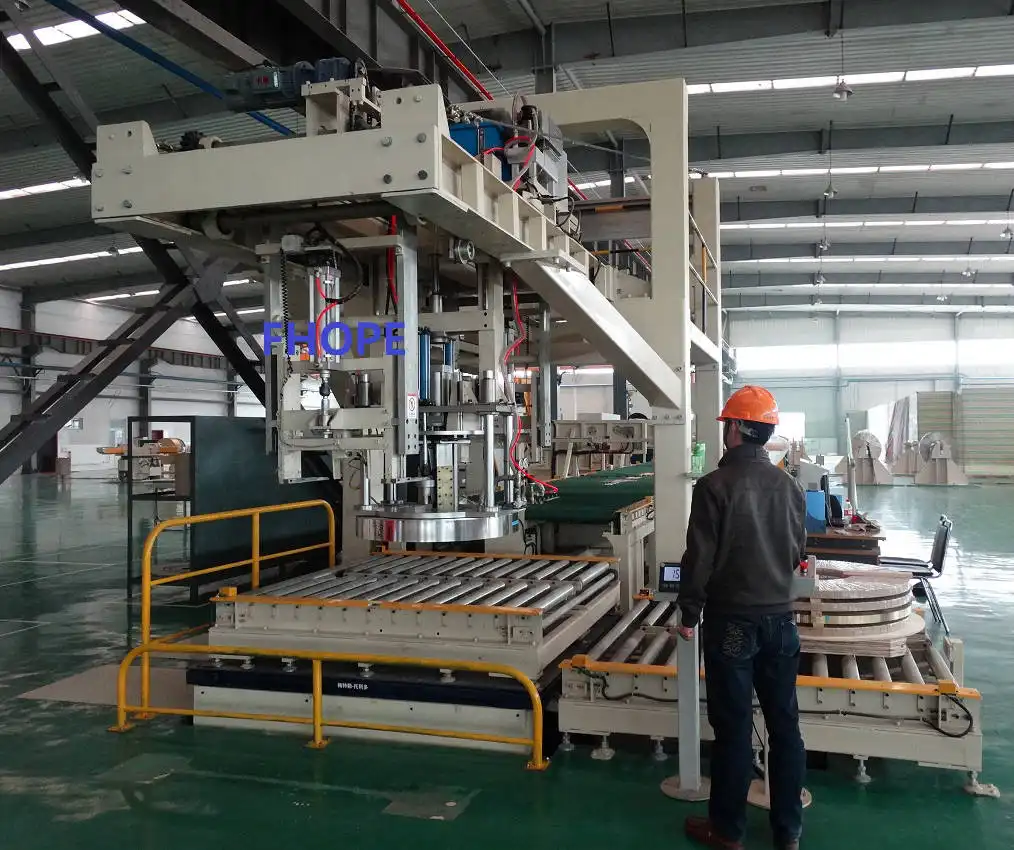Streamlining Operations: A Guide to Automated Slit Coil Strapping and Packing
Handling and packaging slit coils efficiently and safely is a critical challenge in metal processing and fabrication. Manual methods can be labor-intensive, slow, and pose risks to both personnel and product quality. Automated slit coil strapping and packing lines offer a robust solution, integrating various processes into a seamless workflow. This guide explores the key components and benefits of such systems.
Above: Example of an automated slit coil packing system operating in a facility, demonstrating coil pickup from a turnstile and subsequent packaging.
For details on specific configurations, explore options for a steel slit coil packing line. These systems can be integrated directly online with a slitting machine's coil car or function offline, receiving coils via crane loading. Modern systems often include advanced control systems, potentially with IoT capabilities for enhanced monitoring.

Let's break down the typical stages involved in an automated solution designed for coils up to approximately 4000kg:
1. Coil Reception and Handling from Turnstile
- Process: The journey begins as individual slit coils arrive from the slitting line, typically presented on a turnstile.
- Mechanism: Automated coil clamps or specialized vacuum arms, often mounted on a rotating table or robotic arm, engage and pick up each coil.
- Key Feature: Precision gripping is essential to securely hold the coils during transfer without causing distortion or surface damage.
2. Conveyor Infeed and Transport
- Function: Once picked up, coils are transferred onto a network of conveyors.
- Purpose: These conveyors efficiently transport the coils between different stations (strapping, stacking, wrapping).
- Efficiency: Buffer zones or accumulating conveyors can be incorporated to manage fluctuations in the slitting line's output, ensuring a smooth flow to the packing line.
3. Securing the Coil: The Strapping Process
- Objective: Strapping unitizes the slit coil, preventing it from unwinding and making it easier to handle. This is often done radially (through the eye) or circumferentially.
- Strapping Material: While steel straps are traditional, Polyethylene Terephthalate (PET) straps are increasingly common due to their cost-effectiveness, ease of handling, and sufficient strength for many applications.
- PET Strapping Machine:
- Components: Includes a strapping head that feeds, tensions, and seals the PET strap.
- Operation: The head applies the strap around the coil, pulls it to the pre-set tension using tensioning rolls, and then uses a friction weld or heat seal to join the strap ends securely.
- Control: A Programmable Logic Controller (PLC) manages the process, ensuring consistent tension suitable for the specific coil dimensions and weight.
4. Automated Coil Stacking
- Purpose: After strapping, coils often need to be stacked for efficient storage or transport.
- Method: Automated systems use various mechanisms like stacking frames, cradles, or designated rack locations.
- Technology: Grippers, manipulators, or robotic arms carefully lift the strapped coil and place it onto the stack. Sensors detect when a stack reaches its designated height or count, signaling the system to start a new stack. The PLC synchronizes stacking actions with the preceding strapping operation.
5. Protective Packaging Line

- Goal: To protect the coil from environmental factors (moisture, dust) and handling damage.
- Process:
- Coils might be placed onto wrapping mandrels or specialized coil frames.
- Automated wrapping machines apply materials like stretch film, VCI (Vapor Corrosion Inhibitor) film, cardboard sheets, or edge protectors.
- Additional strapping may be applied circumferentially around the outside diameter of the packed coil for final security.
6. Conveyor Outfeed
- Final Stage: Fully strapped, stacked (if applicable), and packed coils are discharged onto outbound conveyors.
- Destination: These conveyors transport the finished coils to a warehouse storage area, marshalling zone, or directly to shipping docks.
7. System Integration and Control
- Brain of the Operation: A central PLC typically orchestrates the entire line, controlling the timing and operation of conveyors, manipulators, strapping heads, wrapping machines, and stacking equipment.
- Operator Interface: A Human-Machine Interface (HMI), usually a touchscreen panel, allows operators to monitor the system's status, adjust parameters (like strap tension or wrap cycles), and troubleshoot alarms.
- Control Levels: Basic (Level 1) controls ensure synchronization and fault detection. More advanced systems might incorporate higher levels of automation and data exchange.
- IoT Connectivity (Optional): Internet of Things (IoT) capabilities enable remote data collection on throughput, cycle times, material consumption, and system health, facilitating condition monitoring and performance optimization.
Benefits of Automated Slit Coil Packing Lines
Implementing an automated system yields significant advantages over manual processes:
- Increased Throughput: Automation enables faster, continuous processing compared to manual handling and packing steps.
- Consistent Quality: Automated machines apply straps, wraps, and protective elements with precision and repeatability, ensuring uniform package quality.
- Reduced Material Waste: Optimized application of strapping and wrapping materials minimizes overuse and scrap.
- Enhanced Safety & Reduced Labor: Minimizing manual lifting and handling of heavy coils significantly improves workplace safety and reduces labor requirements for repetitive tasks.
- Data & Optimization: Systems with IoT connectivity provide valuable operational data for process improvement and predictive maintenance.
By automating the strapping and packing of slit coils, manufacturers can significantly enhance operational efficiency, improve product protection, and create a safer working environment.